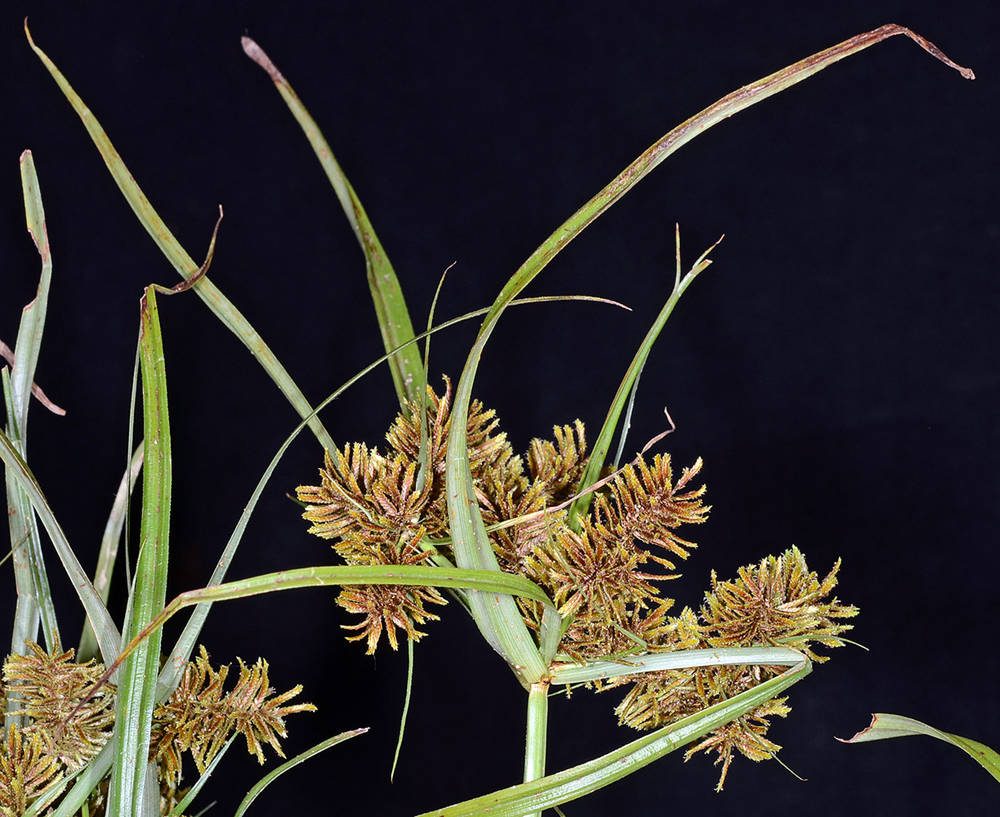
Plants annual, cespitose.
Culms trigonous to roundly trigonous, (0.5)5–25(105) cm × 1–2.5(7.5) mm.
Leaves 5–25(90) cm × 2–5(11) mm.
Inflorescences clusters cylindric, dense, 1–3(6), (4)10–30(45) × (6)10– 16(23) mm; rays 2–6(12), 1–8(28) cm long; inflorescence bracts horizontal to ascending at 30°.
Spikes (20)40–80, linear, quadrangular in cross section, 3–8(11) × 1–1.5 mm; rachilla persistent, at maturity becoming laterally free, remaining firmly attached proximally, wings 0.3(0.4) mm wide; floral scales deciduous, 6–16(30), appressed, oblong-ovate to obovate, 1.3–1.5 × 0.8–1.2 mm, light brown with reddish speckles and greenish midstripe; lateral ribs 0, medial ribs 3; apex obtuse, mucronulate.
Flowers anthers 0.2–0.3 mm, styles 0.7–0.8 mm; stigmas 0.4 mm.
Achenes ovoid, (0.4)0.7–1 × 0.4–0.6 mm.
Shorelines exposed by low water levels. 0–700 m. Casc, Col, CR, ECas, Est, Owy, Sisk, WV. CA, NV, WA; throughout most of US and southern Canada, south to Mexico. Native.
as described under Cyperus erythrorhizos
Herbs, annual, cespitose. Culms trigonous to roundly trigonous, (0.5-)5-25(-105) cm × 1-2.5(-7.5) mm, glabrous. Leaves flat to inversely W-shaped, 5-25(-90) cm × 2-5(-11) mm. Inflorescences: spikes 1-3(-6), rather densely cylindric-ovoid, (4-)10-30(-45) × (6-)10-16(-23) mm; rays 2-6(-12), 1-8(-28) cm; bracts (3-)5-7(-11), horizontal to ascending at 30°, inversely W-shaped, (3-)10-20(-70) cm × 1-3(-12) mm; rachilla persistent, at maturity becoming laterally free, remaining firmly attached proximally, wings 0.3(-0.4) mm wide. Spikelets (20-)40-80, linear, quadrangular, 3-8(-11) × 1-1.5 mm; floral scales deciduous, 6-16(-30), appressed, laterally light brown with reddish speckles, medially greenish, laterally ribless, medially 3-ribbed, oblong-ovate to obovate, quadrangular to subterete, 1.3-1.5 × 0.8-1.2 mm, apex obtuse, mucronulate. Flowers: anthers 0.2-0.3 mm, connectives 0.1 mm; styles 0.7-0.8 mm; stigmas 0.4 mm. Achenes light grayish to brown, sessile, ovoid, 0.4-)0.7-1 × 0.4-0.6 mm, apex rounded, apiculate, surfaces glabrous.Fruiting summer. Emergent shorelines; 0-1500 m; Man., Ont.; Ala., Ariz., Ark., Calif., Conn., Del., D.C., Fla., Ga., Ill., Ind., Iowa, Kans., Ky., La., Maine, Md., Mass., Mich., Minn., Miss., Mo., Nebr., Nev., N.H., N.J., N.Mex., N.Y., N.C., N.Dak., Ohio, Okla., Oreg., Pa., R.I., S.C., S.Dak., Tenn., Tex., Utah, Va., Wash., W.Va., Wis.; Mexico (Baja California).